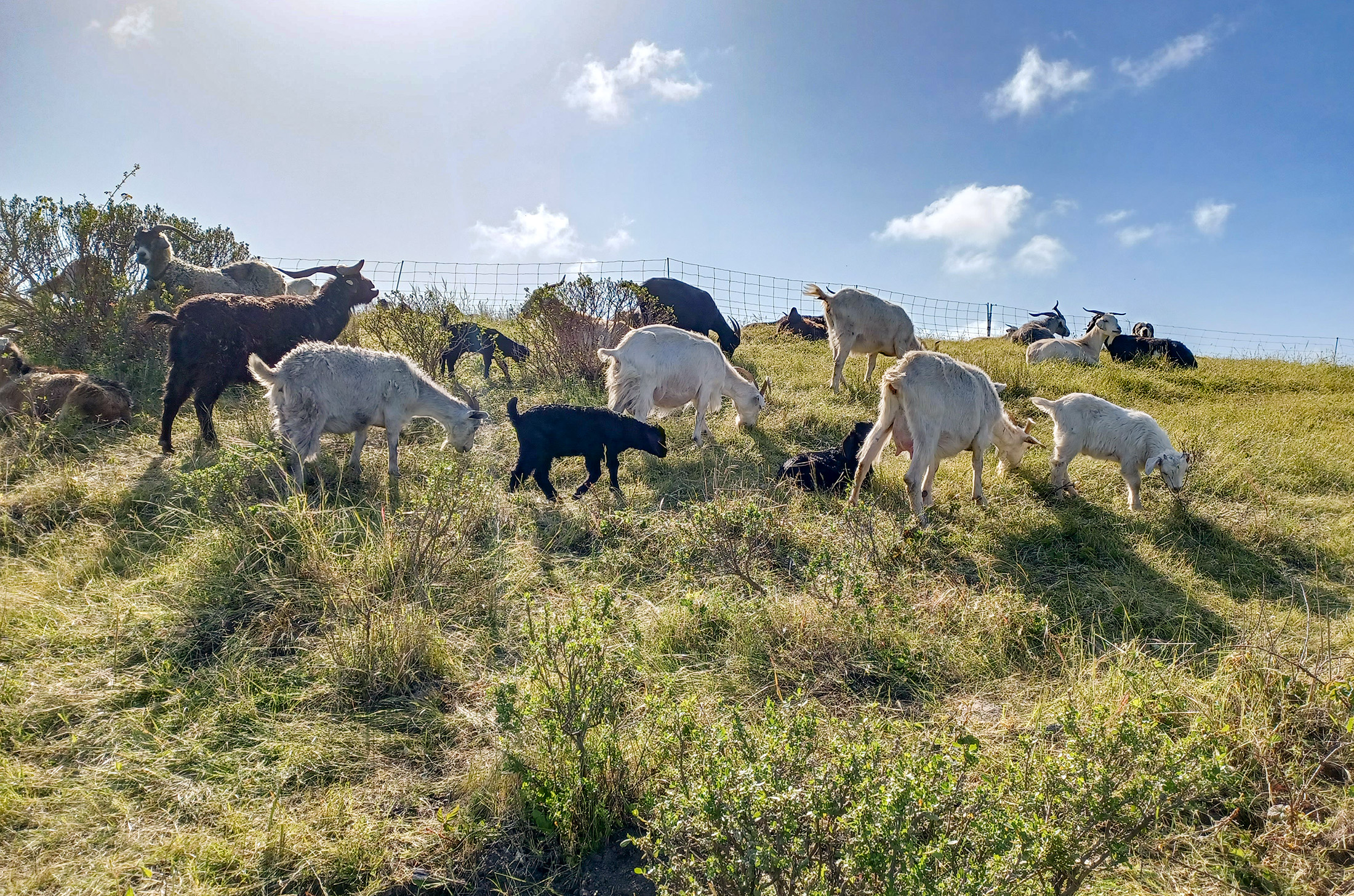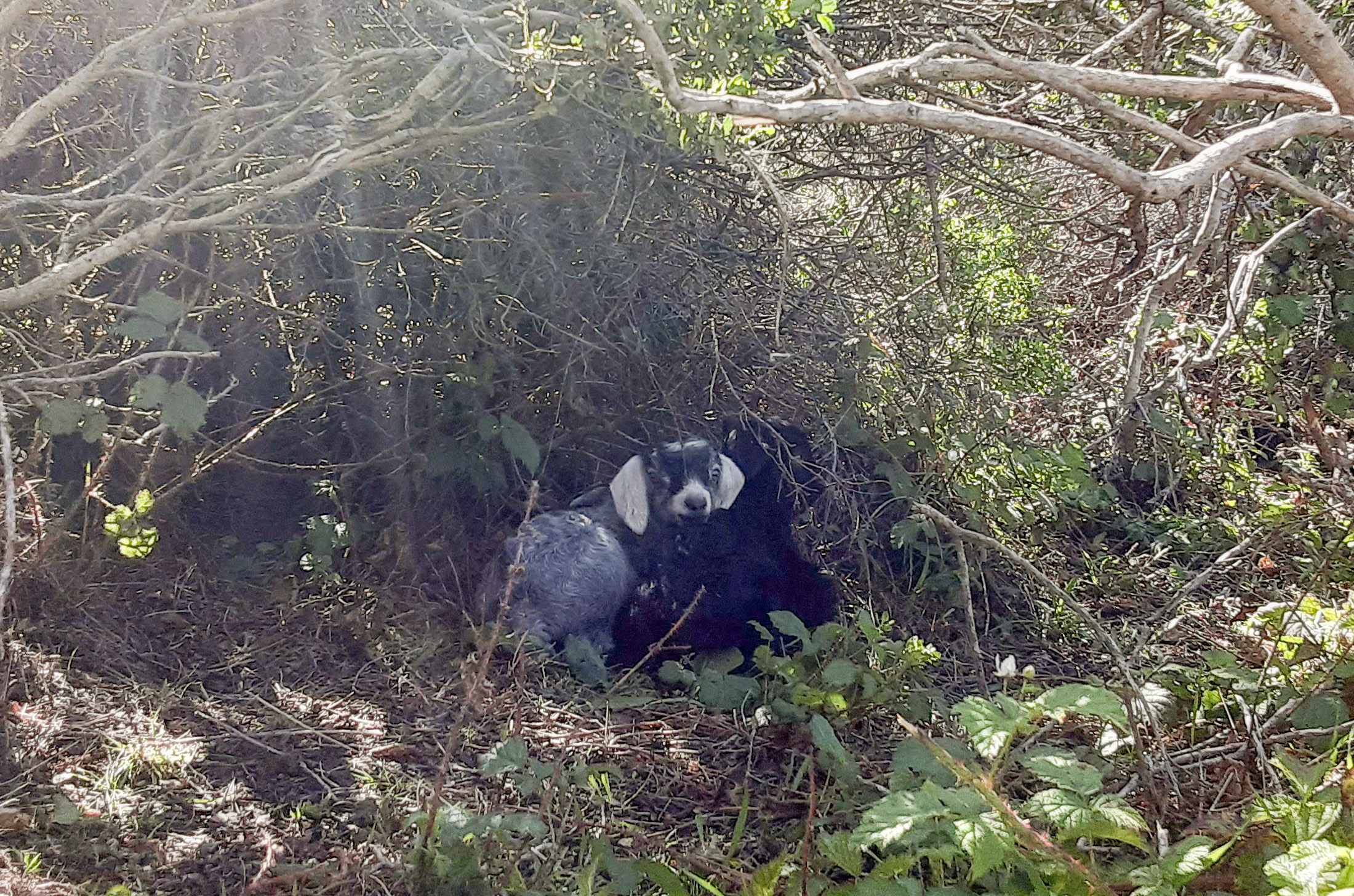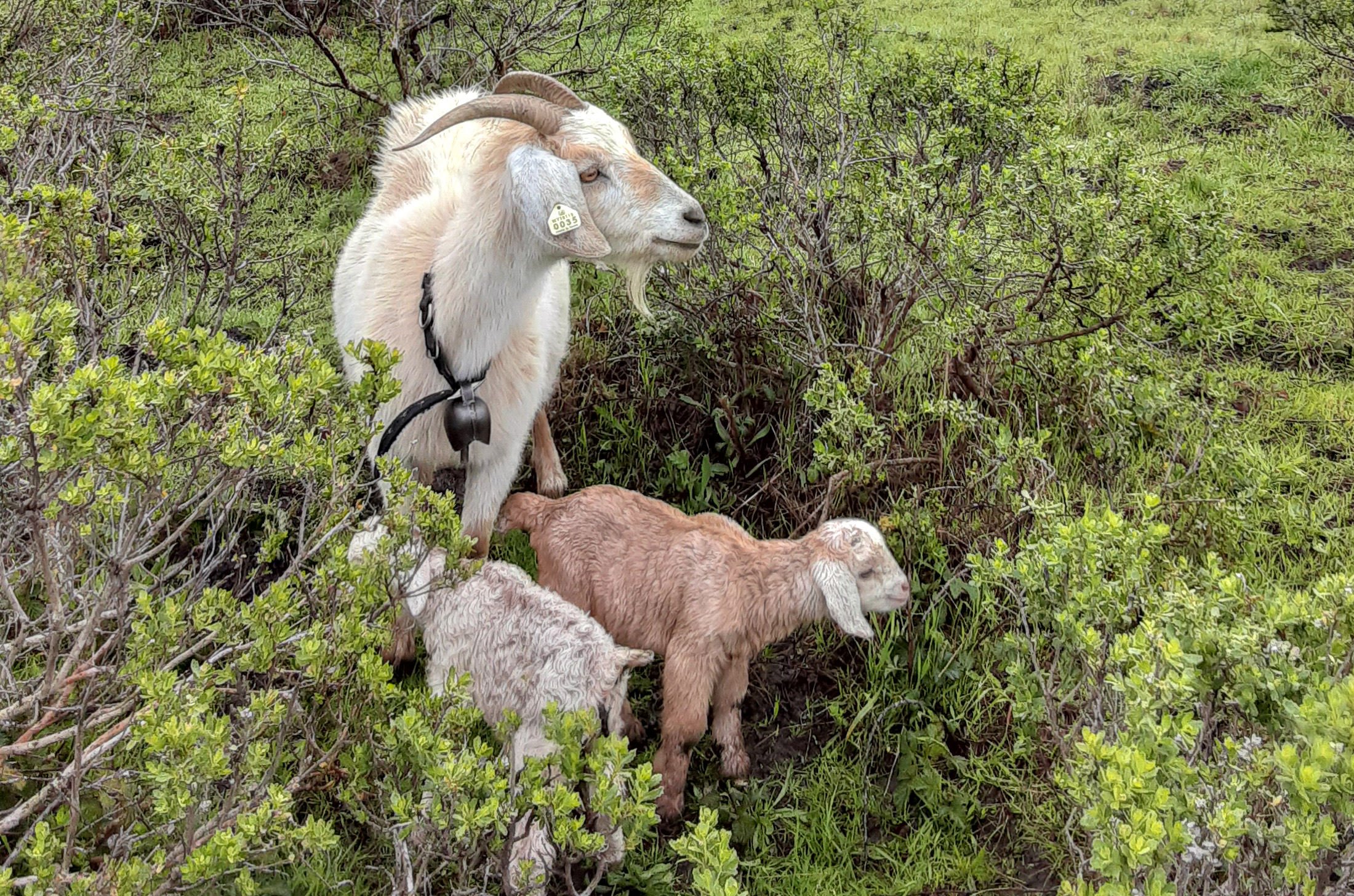Regenerative agriculture seeks to mimic the Earth’s natural cycles. The planned, managed grazing that we implement with our livestock at TomKat Ranch is designed to
Thrifty Herd – Breeding for Successful Adaptation

06/26/2023
Written by Mukethe Kawinzi. Photos by Mukethe Kawinzi.
Reading time: about 8 minutes.
 Regenerative agriculture seeks to mimic the Earth’s natural cycles. The planned, managed grazing that we implement with our livestock at TomKat Ranch is designed to imitate the varied ways that roaming herds once fed the soils of these grasslands. Growing a thriving domesticated goat herd requires that we bring the same intention we employ for effective grazing to breeding and kidding. For the Small Ruminant Program, kidding season is a chance to deliberately work toward our goal of engendering resilient, healthy goats who can weather the caprices of our Mediterranean climate, distinctive forage, and craggy coastal terrain.
Regenerative agriculture seeks to mimic the Earth’s natural cycles. The planned, managed grazing that we implement with our livestock at TomKat Ranch is designed to imitate the varied ways that roaming herds once fed the soils of these grasslands. Growing a thriving domesticated goat herd requires that we bring the same intention we employ for effective grazing to breeding and kidding. For the Small Ruminant Program, kidding season is a chance to deliberately work toward our goal of engendering resilient, healthy goats who can weather the caprices of our Mediterranean climate, distinctive forage, and craggy coastal terrain.
Our brief, one-month kidding season came to a successful end in April and resulted in 41 new healthy, kicking kids who are now out on the range with the larger herd. Our breeding program is new—our does have only been bred once on the ranch—but our objective is clear: to establish a strong, thrifty, adaptive range herd that thrives with minimal intervention and minimal inputs in our landscape. During kidding season, our focus falls on: (1) building strong genetics through a robust breeding strategy; and (2) implementing kidding in a way that privileges the mother-kid bonding that forms the foundation of herd connections and dynamics.

GENETICS & BREEDING
Last year, ahead of the breeding season, our team came together to discuss the genetics we want to build in the herd as it expands in number. The Small Ruminant Program assessed potential bucks along a number of axes, including fecundity, temperament, and parasite resistance. The selected buck came from an open range California environment with stockdogs, which will ideally complement the vigor, self-sufficiency, and herd-bound instincts of our current herd. He also hails from some of the same Spanish cashmere genetics we believe helped our herd repel water and maintain warmth during the severe storms of the past winter season. As we watch his progeny develop, we look forward to evaluating how his individual amalgamation of traits complements the existing strengths of our current herd.
Just as imperative are the female goats who will gestate, birth, and care for the kids to come. Our program maintains a keen eye on the does during and after pregnancy to determine if they should be bred in future years. As they kid, they are closely observed to assess if and when we need to provide aid and also as a means of discerning their aptitude for motherhood. Do they clean their kids quickly and thoroughly? Are they gentle but firm in encouraging their kids to nurse quickly? How attentive are they in ensuring their kids are safe and continually well-fed? These are the instinctual genetics we wish to build in our herd, which will minimize the need for intervention and demonstrate an ability to thrive independently on the range. Unusual presentations, dystocia, and lactation problems can be common in herds raised in conventional environments. At TomKat, the few does who display these issues stay on the range with the herd and contribute to our land management work, but will not be asked to give birth in future years.

The timing of breeding has a number of cascading effects and the Small Ruminant Program chooses to breed for ideal environmental conditions throughout gestation. As we choose to breed in November, we work in October to increase the nutritional plane of the female goats before they are bred, a process referred to as flushing. Grazing is planned throughout the year to ensure sufficient quantity and diversity of stockpiled forage in the weeks before breeding begins. As herders, we can also utilize circuit grazing to bring our goats to riparian areas where plants are still vegetative—and therefore higher in nutrition—later in the year. The movement associated with circuit grazing also provides supplemental exercise, increasing the fitness of the does as they enter breeding. The flushing process supports ovulation and implantation, increasing the likelihood of successful pregnancies across the herd. At the same time, this access to increased fresh forage and energy supports the buck in his demanding work.
The gestation period for goats is about five months; breeding in November results in our first births arriving in late spring. By the end of March, when our kidding season began, the winter cold and rains had come to a rest. The spring growth of trees and shrubs was available to provide safe shelter for new kids. At the same time, fresh grasses afforded the lactating does the increased nutritional intake they needed to produce milk for their new offspring. Once kids are ready to start eating fresh forage, at roughly two weeks of age, nutrient quality is high and robust. This is another way in which our work mimics and draws from nature; we choose breeding and kidding periods that reflect when wild grazers give birth. Thus, the singular decision of when to breed broadly supports the progressive health of the herd.

GESTATION & KIDDING
As we move from breeding to the gestation period our focus shifts to the development and well-being of the does and their developing fetuses. It is also a time when our commitment to low-stress livestock handling advances the robustness and resilience of our animals.
Throughout the year, we manage our goat herd in reflection of the principles of stockman Bud Williams, whose approach prioritizes the physical and psychological well-being of livestock animals. The benefits of low-stress stockmanship extend to the gestation period, during which handling can affect the health of both the pregnant doe and the kids yet to be birthed. A number of studies have shown the impact of aversive versus minimal handling; a 2016 study with dairy goats showed how handling during pregnancy impacts fetal development, the post-birth maternal behaviors that provide kids their first boost of care and health, and early behavioral development in kids like suckling and standing.
Respecting the physicality and the mindset of the animal remains important as birthing begins. It is incredibly common for newborn kids to be handled immediately after birth. However, in working toward our goal—a strong, thrifty, adaptive range herd—we aspire to intervene and handle kids only when necessary. The initial days after birth are imperative to establishing a connection between mother dam and kid; early hormonal, sensory, olfactory, and acoustic stimuli result in bonding and recognition. There is extensive research demonstrating how outside stimuli like handling and medications break these bonds and can lead to lifelong negative health and performance outcomes, though low-intervention approaches to kidding remain relatively rare in much of conventional agriculture. Rather than quickly removing kids from their mothers for assessment and processing, we batch-processed (tagged and castrated) all kids together two weeks after the final birth of the season, after which they were immediately released back to their mothers and the herd. Similarly, the Small Ruminant Program decided against the use of vaccines for kids born this year. Our herd, with frequent access to fresh pasture and free of the confinement conditions that cause many livestock diseases, exist firmly outside of the environments that often facilitate bacterial and viral infection. We are closely monitoring how our management and the herd’s own instincts will continue to protect them from disease; as with all our decisions, we will observe and iterate as necessary.

These bonds are the foundation of the herd; having a cohesive family unit helps the goats survive predators, find good forage, and protect themselves from harsh weather. Similarly, those early olfactory and acoustic cues persist: as the herd moves and grazes, mothers and kids are often heard bleating back and forth, using their ability to distinguish each individual’s call to confirm each other’s presence and safety. When called, the kids run to their mothers for a quick feeding of milk; she uses this opportunity to take in their smell, ensuring they are indeed her kids and are in good health.
Our choice to employ drift kidding complements the low-stress handling approach. In drift kidding, a new area of forage is opened in front of the herd every one to two days, while the longest-opened portion in the back is closed off. This keeps the herd moving along contiguous pasture at a deliberate pace, providing new feed while also giving pregnant does and new dams time to catch up with the herd. As does give birth, they choose an isolated nesting area to stash their kids for safety and security. Most prefer to graze in the area immediately surrounding these nests, allowing them to maintain proximity to and keep attention on their kids in the first few days post-birth. Moving the herd too far too soon can be stressful and cause does to lose their nest or their kids. Thus, drift kidding ensures fresh forage, plenty of space for new dams and kids to bond, and time for dams to make sure their kids are vigorous enough to emerge from their nests and enter the larger herd.
By giving our mother dams and their new kids space and time to bond—all while observing from afar and prepared to intervene when truly necessary—we ensure familial bonds that will persist as the herd continues to grow. It is an opportunity for the kids to demonstrate the thrift they will need throughout their lives, a chance to grow and show the strength to survive in our specific context.

Our animals both live from and feed the land. From their first days, the kids see previous generations in the herd traversing pastures, selecting plants their bodies need most. They are able to follow along as the herd travels deep into browse, simultaneously balancing their guts and managing brush encroachment. After a mere two weeks, they start to nibble their first tastes of green feed, standing alongside their mothers and starting the behavior that will allow them to thrive on—and impact—our landscape for years to come. These initial exposures ensure that they have a taste for and ability to digestively manage the brush, thistle, and other invasives we are targeting as we bring our landscape into balance.
As ranchers with a holistic gaze, we plan intensively while recognizing that every kidding season is a path into the unknown. Trust in our stock and our methods prevailed, however, and kidding season came to a close with a sense of calm and triumph. Every kid born alive survived and all are flourishing; we did not lose a single dam to childbirth or complications. This year, we’ll further refine our buck selection process with an eye toward fine-tuning herd genetics. We will continue to work in harmony with our goats so that they can act in harmony with the land. With forty-one new kids on the range, we’re eager to keep learning what impact the herd will have as we continue to target invasive species, increase biodiversity, promote soil health, reduce fuel loads, and regenerate our rangelands.